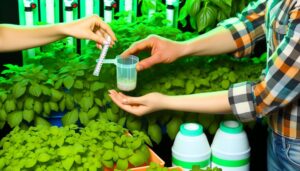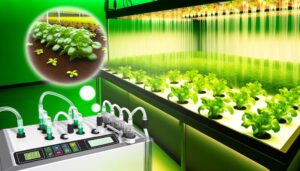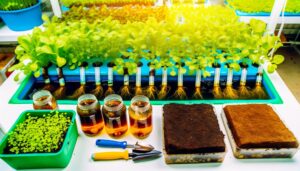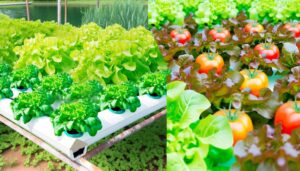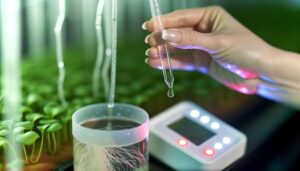Hydroponic Nutrient Solution for Spinach
A successful hydroponic nutrient solution for spinach must include balanced macronutrients (N-P-K at 4:1:2) and essential micronutrients like iron, zinc, and manganese for robust growth. Ideal pH levels should be maintained between 5.8 and 6.2, with electrical conductivity (EC) in the range of 1.8 to 2.3 mS/cm.
Proper nutrient management and regular monitoring are critical to prevent deficiencies such as nitrogen chlorosis or phosphorus stunting. Additionally, utilize purified water with total dissolved solids (TDS) below 200 ppm to guarantee effective nutrient absorption.
Keeping these factors in check maximizes yield and quality – discover more about fine-tuning this process.

Key Takeaways
- Maintain pH between 5.8 and 6.2 for optimal nutrient availability.
- Use an N-P-K ratio of 4:1:2 for balanced spinach growth.
- Ensure electrical conductivity (EC) is between 1.8 to 2.3 mS/cm.
- Regularly monitor and adjust micronutrient levels to prevent deficiencies.
Essential Nutrients for Spinach
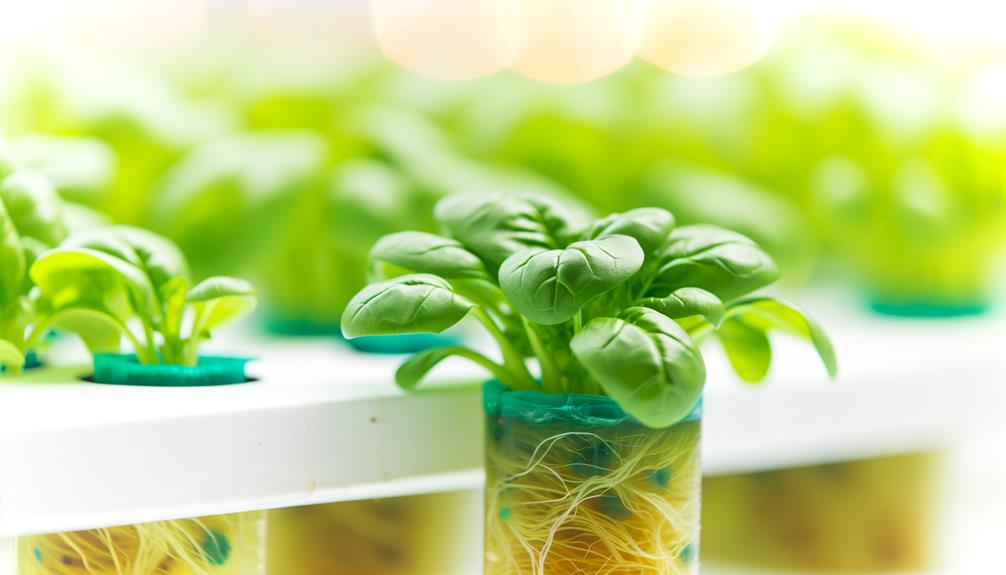
Ensuring the ideal growth of hydroponically cultivated spinach necessitates a thorough understanding of the essential nutrients required, including macronutrients like nitrogen (N), phosphorus (P), and potassium (K), as well as micronutrients such as iron (Fe), manganese (Mn), and zinc (Zn).
Research indicates that nitrogen is critical for leaf development, phosphorus supports root growth and energy transfer, and potassium enhances overall plant vigor and disease resistance.
Micronutrients, though required in smaller quantities, are equally crucial; iron is a key component of chlorophyll synthesis, manganese influences photosynthesis and nitrogen assimilation, and zinc is essential for enzyme function and protein synthesis.
Optimal nutrient concentration and balance are paramount to achieving maximum yield and quality in hydroponic spinach cultivation.
Macronutrients Breakdown
Macronutrient management in hydroponic spinach cultivation involves precise control of nitrogen, phosphorus, and potassium levels to optimize plant growth and yield.
Nitrogen (N) is critical for vegetative growth, promoting lush, green leaves through its role in chlorophyll synthesis.
Phosphorus (P) is essential for energy transfer and root development, playing a key role in ATP production.
Potassium (K) enhances overall plant vigor, improving water uptake, enzyme activation, and resistance to diseases.
- Nitrogen (N): Key for chlorophyll production and leaf growth.
- Phosphorus (P): Crucial for energy transfer and root system development.
Proper balancing of these macronutrients guarantees robust spinach growth and maximizes yield potential.
Micronutrients for Growth
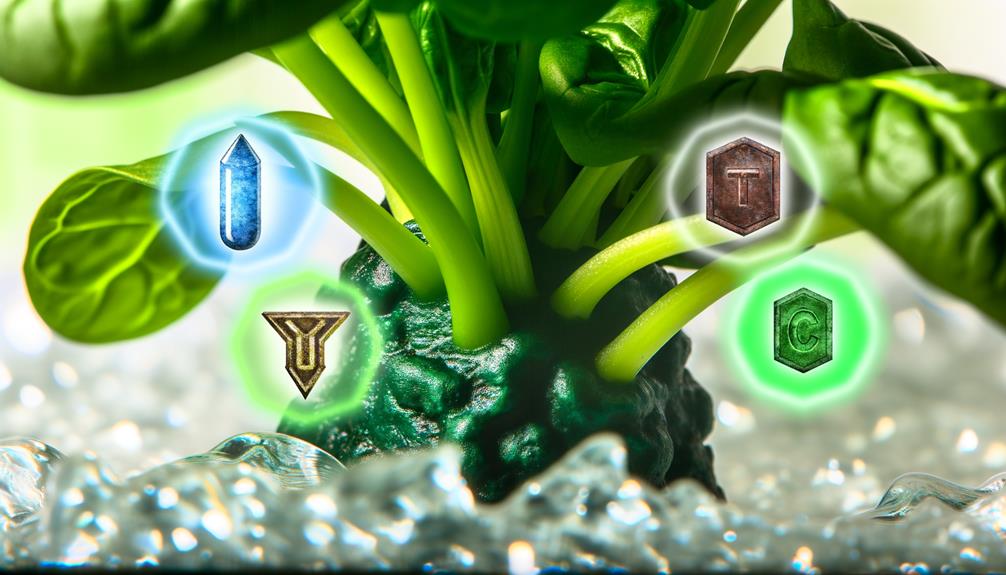
Micronutrients, though required in smaller quantities than macronutrients, are indispensable for the physiological and biochemical processes that drive optimal spinach growth in hydroponic systems.
Critical micronutrients include iron (Fe), manganese (Mn), zinc (Zn), copper (Cu), boron (B), molybdenum (Mo), and chlorine (Cl).
Research indicates ideal concentrations for spinach: Fe (1-2 ppm), Mn (0.5-1 ppm), Zn (0.02-0.05 ppm), Cu (0.01-0.05 ppm), B (0.2-0.5 ppm), Mo (0.01-0.05 ppm), and Cl (0.1-0.5 ppm).
Each micronutrient plays a specific role, such as Fe in chlorophyll synthesis and Zn as a cofactor for enzymatic reactions.
Deficiencies or toxicities can lead to stunted growth and poor yield, emphasizing the need for precise nutrient management.
Ideal Ph Levels
Maintaining an ideal pH level between 5.8 and 6.2 is crucial for maximizing nutrient availability and uptake in hydroponic spinach cultivation. Research indicates that pH levels within this range optimize the solubility of key macronutrients such as nitrogen, phosphorus, and potassium, which are critical for spinach growth.
Studies have shown that deviations from this pH window can lead to nutrient lockout, where essential minerals become inaccessible to the plant roots.
- Optimal Nutrient Absorption: Guarantees spinach receives balanced nutrition for robust growth.
- Prevention of Nutrient Deficiency: Minimizes risks of micronutrient deficiencies that can hinder development.
Maintaining these pH levels requires regular monitoring and adjustments.
Mixing Your Solution
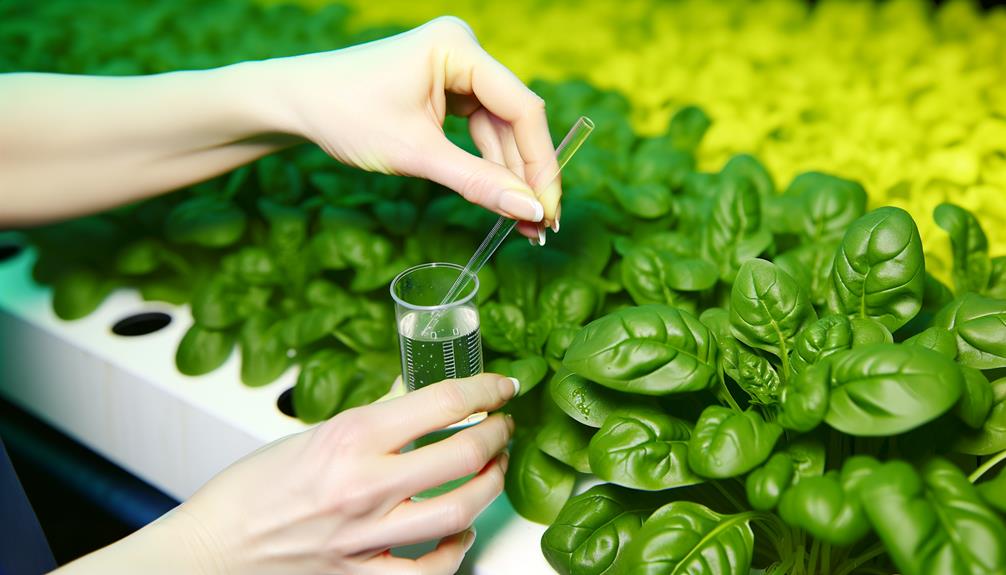
To achieve an ideal nutrient solution for hydroponic spinach, precise measurement and mixing of the components are essential.
Begin by weighing the required quantities of macronutrients—nitrogen, phosphorus, and potassium—based on spinach's specific needs. Data from recent studies suggest a suitable N-P-K ratio of 4:1:2.
Integrate micronutrients such as iron, manganese, and boron at trace levels, adhering to recommended concentrations.
Utilize a calibrated digital scale for accuracy, and dissolve each component thoroughly in distilled water to prevent nutrient lockout. Continuous agitation during mixing guarantees homogeneity.
Employing a conductivity meter, target an electrical conductivity (EC) range of 1.8-2.3 mS/cm.
Adherence to these guidelines will facilitate nutrient availability, promoting robust spinach growth.
Best Water Sources
When selecting the ideal water source for hydroponic spinach, researchers must consider the implications of tap water quality, including potential contaminants and mineral content.
Purified water, such as reverse osmosis-treated or distilled water, offers distinct advantages by providing a consistent and controlled baseline free from impurities.
Empirical data underscores the importance of water purity in achieving ideal nutrient uptake and plant health.
Tap Water Considerations
Selecting the best water source for hydroponic nutrient solutions is crucial, as the quality of tap water can greatly impact the growth and health of spinach. Tap water commonly contains various dissolved minerals and impurities that can affect nutrient uptake and pH balance. It is essential to test and adjust the water quality to ensure optimal conditions for plant growth. For growers using a hydroponic nutrient solution Kenya, filtering or using reverse osmosis water can help remove unwanted impurities and stabilize pH levels. By maintaining a well-balanced solution, spinach plants can absorb nutrients efficiently, leading to healthier growth and higher yields.
Research indicates that water with a high concentration of calcium and magnesium can lead to nutrient imbalances, whereas excessive chlorine levels may inhibit root development. Consequently, it is vital to test and adjust tap water parameters before use.
- Total Dissolved Solids (TDS): Aim for a TDS level below 200 ppm for ideal nutrient absorption.
- pH Level: Maintain a pH range between 5.5 and 6.5 to guarantee nutrient availability.
Purified Water Benefits
Given the potential issues associated with tap water, utilizing purified water sources such as reverse osmosis or distilled water can greatly enhance the nutrient solution's efficacy for hydroponic spinach cultivation.
Research indicates that purified water eliminates contaminants like chlorine, chloramine, and heavy metals, which can interfere with nutrient uptake and plant health.
Reverse osmosis systems, for instance, can remove up to 99% of dissolved solids, ensuring a stable and controlled nutrient environment.
Distilled water, devoid of impurities, offers a consistent baseline for nutrient formulation.
Studies have shown that using purified water improves root development and overall plant vigor, resulting in higher yields and better-quality spinach.
As a result, investing in purified water sources is essential for optimizing hydroponic spinach production.
Monitoring Nutrient Levels
Effective monitoring of nutrient levels in hydroponic systems is essential for maximizing spinach growth, focusing on maintaining precise essential nutrient ratios, and ensuring proper pH and electrical conductivity (EC) balance.
Research indicates that fluctuations in these parameters can greatly impact nutrient uptake and overall plant health.
Regular data collection and analysis are recommended to sustain ideal growing conditions and achieve maximum yield.
Essential Nutrient Ratios
Monitoring nutrient levels in hydroponic systems is critical for maximizing the essential nutrient ratios required for the healthy growth of spinach. Research indicates that spinach demands a specific balance of macronutrients and micronutrients to thrive.
Key ratios include:
- Nitrogen (N), Phosphorus (P), and Potassium (K): A balanced N-P-K ratio of 4:1:2 is generally recommended.
- Calcium (Ca) and Magnesium (Mg): Maintain a Ca:Mg ratio of approximately 3:1 to prevent nutrient lockout.
Regular monitoring using precise instrumentation is essential to maintain these ratios, ensuring the hydroponic nutrient solution supports robust spinach growth.
Ph and EC Balance
Maintaining ideal pH and electrical conductivity (EC) levels is essential for guaranteeing nutrient availability and uptake in hydroponic spinach cultivation.
Research indicates that the best pH range for spinach is between 5.8 and 6.2. Deviations can impair nutrient solubility, leading to deficiencies or toxicities.
Concurrently, EC should be maintained between 1.8 to 2.3 mS/cm to guarantee ideal ion concentration. Regular monitoring and adjustments using calibrated meters and appropriate buffering solutions are imperative.
Studies show that consistent pH and EC levels result in higher yield and better quality of spinach. Additionally, automated systems can provide real-time data, facilitating precise control.
Therefore, meticulous management of pH and EC not only enhances growth but also guarantees nutrient efficiency.
Adjusting Ph and EC
Guaranteeing ideal pH and Electrical Conductivity (EC) levels is critical for maximizing nutrient uptake and achieving robust growth in hydroponically grown spinach.
pH should be maintained between 5.8 and 6.2 to optimize nutrient solubility. Continuous monitoring and adjustment are essential, as fluctuations can impede nutrient availability.
EC, representing the concentration of dissolved salts, should be kept between 1.2 and 2.0 mS/cm.
Key considerations include:
- pH Adjustment: Use pH up or down solutions to correct deviations; guarantee gradual changes to avoid shocking the plants.
- EC Management: Regularly calibrate EC meters and adjust nutrient solution concentrations accordingly.
Common Deficiencies
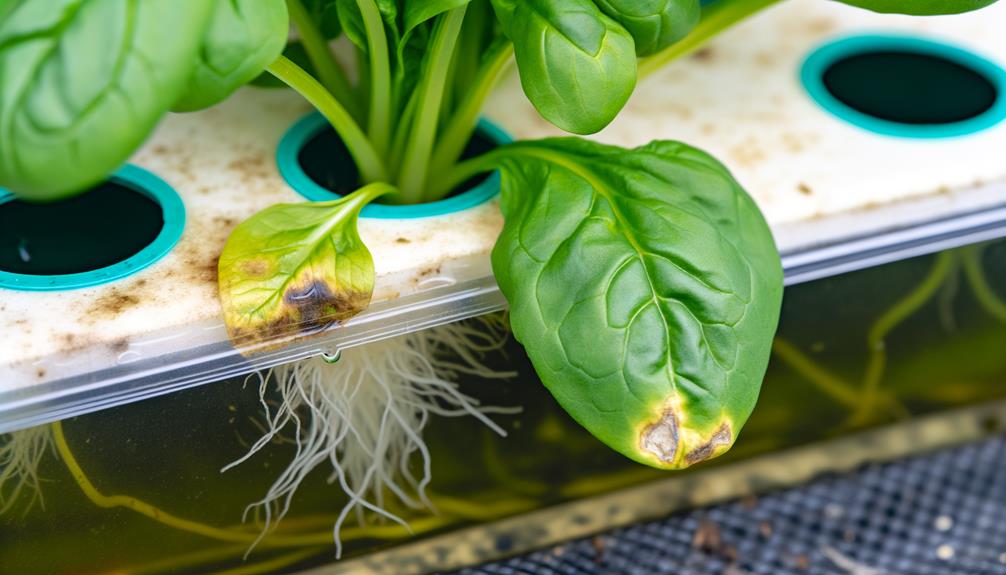
Understanding the common nutrient deficiencies that can arise in hydroponically grown spinach is paramount to preemptively addressing issues that might hinder plant health and productivity.
Nitrogen deficiency, evidenced by chlorosis in older leaves, is a frequent concern.
Phosphorus deficiency manifests through stunted growth and dark green or purplish leaves.
Potassium deficiency can lead to marginal leaf burn and necrosis.
Calcium deficiency, often identified by distorted leaf tips and blossom end rot, is critical in young tissues.
Magnesium deficiency presents as interveinal chlorosis in older leaves.
Monitoring and adjusting nutrient concentrations based on empirical data and research are vital to mitigate these deficiencies.
Addressing these issues promptly guarantees robust spinach growth and maximum yield in hydroponic systems.
Nutrient Solution Maintenance
Effective maintenance of the hydroponic nutrient solution is critical for peak spinach growth, necessitating regular monitoring of pH levels to guarantee they remain within the ideal range of 5.8 to 6.2.
Adjusting nutrient concentration based on real-time data from electrical conductivity (EC) measurements can prevent deficiencies and toxicities.
Additionally, implementing strategies to prevent algae growth, such as using opaque containers and maintaining proper sanitation, guarantees nutrient uptake efficiency and system longevity.
Monitor Ph Levels Regularly
Maintaining ideal pH levels between 5.5 and 6.5 is essential for the efficient absorption of nutrients in hydroponic spinach cultivation. Research indicates that deviations from this range can hinder nutrient uptake, leading to subpar growth and yield.
Regular monitoring using pH meters or test kits is critical to guarantee that the nutrient solution remains within this prime range. Data-driven adjustments based on monitored pH values can prevent nutrient lockout and imbalances.
- Consistency: Monitor pH levels daily to maintain a stable environment.
- Technology: Utilize digital pH meters for precise and reliable readings.
Adjust Nutrient Concentration
Maintaining ideal nutrient concentration in the hydroponic solution is vital for maximizing spinach growth and yield.
Research indicates that spinach thrives in a nutrient solution with an electrical conductivity (EC) range of 1.8 to 2.2 mS/cm. Deviations from this range can lead to nutrient imbalances, reduced growth rates, and compromised leaf quality. Regularly measuring and adjusting the EC helps maintain peak nutrient availability.
Additionally, it's important to monitor the levels of key macronutrients like nitrogen, phosphorus, and potassium, as well as essential micronutrients such as iron, manganese, and zinc.
Utilizing precise dosing systems and periodic laboratory testing can guarantee nutrient concentrations remain within the desired parameters, thereby promoting vigorous spinach development and high marketable yields.
Prevent Algae Growth
To maintain ideal nutrient conditions for spinach, it is equally important to implement strategies that prevent algae growth in the hydroponic solution.
Algae can deplete essential nutrients and oxygen, compromising plant health and yield.
Research indicates that light exclusion is paramount; covering nutrient reservoirs with opaque materials can greatly reduce algae proliferation.
Additionally, maintaining a water temperature below 24°C (75°F) limits algae growth, as they thrive in warmer conditions.
Employing UV sterilizers in the hydroponic system can further inhibit algae development by disrupting cellular processes.
- Light Exclusion: Cover nutrient reservoirs to block light.
- Temperature Control: Keep water temperature below 24°C (75°F).
Hydroponic System Tips
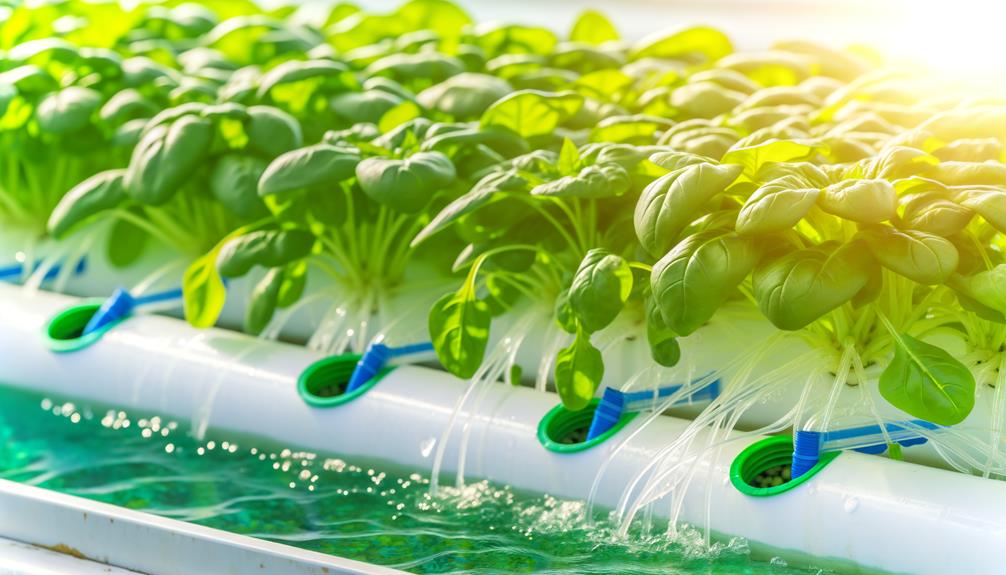
Consistently refining the pH and electrical conductivity (EC) levels is essential for achieving ideal growth in hydroponically grown spinach. Research indicates that a pH range of 5.8 to 6.2 and an EC of 1.8 to 2.3 mS/cm are prime conditions. Monitoring these parameters daily can prevent nutrient lockout and promote efficient nutrient uptake. Additionally, maintaining a stable water temperature between 18°C to 24°C enhances root health and growth rates. Employing a dissolved oxygen (DO) concentration of at least 5 mg/L guarantees adequate oxygen availability. Below is a summary table of key parameters:
| Parameter | Prime Range | Importance |
|---|---|---|
| pH | 5.8 – 6.2 | Prevents nutrient lockout |
| EC | 1.8 – 2.3 mS/cm | Guarantees nutrient availability |
| Water Temperature | 18°C – 24°C | Promotes root health |
| DO Concentration | ≥ 5 mg/L | Guarantees oxygen availability |
| Light Intensity | 200 – 400 µmol/m²/s | Supports photosynthesis and growth |
Conclusion
In hydroponic cultivation of spinach, the precise balance of macronutrients and micronutrients is paramount for optimal growth.
Ensuring the ideal pH levels and regular adjustment of both pH and electrical conductivity (EC) are critical.
Addressing common deficiencies and maintaining nutrient solution integrity are key.
Effective management of these variables, juxtaposed with the implementation of tailored hydroponic system tips, can considerably enhance yield and quality, ultimately leading to a successful and efficient spinach cultivation process.

